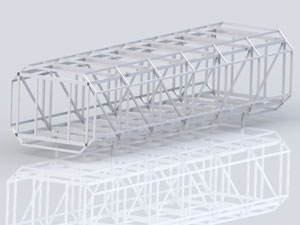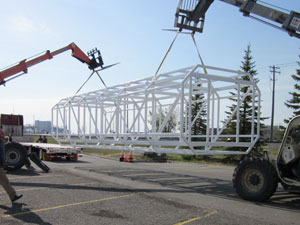Planetary Exploration Initiative
As part of the NASA EPSCoR CAN 2009 grant, "Integrated Strategies for the Human Exploration of the Moon and Mars," our team is developing an Inflatable Lunar Habitat (ILH) and building two electric rovers. Once finished, these prototypes will be tested, together with two NDX-2 space suits, in the North Dakota Badlands. This project will allow the team to develop a complete minimal mission scenario to attempt and address all of the different problems related to a human mission to the Moon or Mars.
The most recent EPSCoR grant will be dispersed over three years and will support the Multi-Purpose Research Station in North Dakota in support of NASA's future human missions to Mars. This $750,000 grant will support research and infrastructure needs of the UND Inflatable Mars/Lunar Habitat and increase the availability of Graduate Research Assistantships for UND students.
Inflatable Lunar Habitat
The Inflatable Lunar Habitat (ILH) consists of a rigid frame that is covered by an inflatable bladder. This arrangement allows both tensile and compressive loads to be transferred from the soft fabric to the rigid frame, avoiding punctures or penetrations. The inflatable material is malleable and retains strength during folding. It is also lightweight and stows in a significantly smaller volume. An expandable soft goods structure offers a lower mass solution, with increased volume versus using metal or rigid composite materials. The UND ILH is being built for a crew of four astronauts during a six-month duration mission. The interior consists of four sleeping compartments where the astronauts are able to rest as well as stow their personal belongings. Inside the ILH there is also a small galley/dining room, a bathroom, and plenty of laboratory space. The habitat is about 40 feet long, 10 feet wide, and 8 feet high, and was completed in 2012.


Analog Missions
To date, there have been four analog missions conducted in the habitat. The initial 10-day analog mission took place in October/November 2013; the second mission took place over 30 days. The third was a 10-day isolation analog mission that was meant to simulate the initial landing period on Mars when there would be no opportunity to explore outside the habitat due to the effects of microgravity on the human body. The fourth mission tested the two new modules installed, a Plants Production Module, and an EVA Module. More information about the analog missions can be found on our blog. The mission crews were space studies graduate students, of which 3 were inside the habitat in each mission, with mission support crew available 24/7 to assist them in missions and logistics.
Electric Rovers
The project involves the design and construction of two electric rovers: one Pressurized Electric Rover (PER), and one Unpressurized Electric Rover (UPER). The PER will provide accommodation for a crew of two astronauts during missions and an additional two members in an emergency situation. It will also contain a common airlock interface between both the astronauts' space suits and their habitat. This will allow the crew to exit the rover safely onto the planetary surface in their suits, and to enter the habitat unsuited while wasting as little expelled gas as possible.
This preliminary design is being built with the cooperation of Cirrus Design of Grand Forks, and consists of a converted electric vehicle, enclosed with a composite shell. It is equipped with communication systems and a station to store soil samples for transportation back to the habitat. The 1G testing of this pressurized rover will show the feasibility of the common airlock system, its ability to safely and reliably conduct experiments, and easily transport its crew across rough terrain.
In cooperation with NASA's Marshall Space Flight Center, the rover and habitat will be outfitted with sample collecting boxes. These boxes will be transferred into the rover during field testing via a secure mini airlock. The airlock will be located on the floor of the back of the rover, between the two planetary exploration suits. Once inside, the sample boxes will be transferred into the habitat through the entryway. The samples can be opened and manipulated inside the lab using a glove box built by the Marshall Space Flight Center.
Currently, with multiple future scenarios to return to the Moon and for the exploration of Mars, any astronaut will be in need of transportation to conduct experiments, for operations, and to have a place of safety in case of emergency. Having a pressurized lunar rover may be the only practical way for any future human missions to the Moon or Mars to be productive and safe at the same time.
The UPER will be based on the same initial PER design. It shall accommodate a four-member crew and it will serve as a transport back-up for the PER for eventual problems, such as derailment on soft terrain, mechanical failures, etc.

